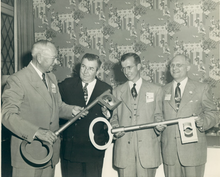
A speed nut, aka sheet metal nut or Tinnerman nut, is a type of locknut with two sheet metal prongs that act as one thread. They are made from spring steel.
Description
The fastener serves the functions of both a lock washer and a nut. As the fastener is tightened in the nut the prongs are drawn inward until they exert pressure on the root of the thread on the fastener. When the fastener is tightened, the base of the nut, which is arched, elastically deforms and applies a force to the fastener, which locks it from loosening under vibrations.
There are many different types of speed nuts, mostly dependent on the shape of the nut, how it attaches to the workpiece, and what type of screw can be used. Most types are designed for either machine screws or sheet metal screws. Some nuts do not attach to the workpiece. These are usually shaped as either a rectangle, a flange nut, or a hex nut; the rectangular speed nut is also known as a flat-style speed nut. Speed nuts that attach to the workpiece usually are some form of a J-nut or U-nut.
History

The speed nut was invented in 1923 and patented in 1924 by Albert H. Tinnerman, son of George Tinnerman, who founded Tinnerman Steel Range Company. The company, established in 1870, originally manufactured sheet metal kitchen ranges. However, after Tinnerman invented the nut to resolve issues with stove shipping, the invention became so successful it led the company away from building stoves to building fasteners.
Tinnerman Products was formed in 1939, and evolved from the Speed Nut development with manufacturing plants in Cleveland, Ohio. A manufacturing plant was constructed on Brookpark Road in the early 1950s. Tinnerman Products later merged with Eaton Yale & Towne in 1969. In 1999, Eaton sold Tinnerman to TransTechnology for $173 million. In 2009, ARaymond purchased Tinnerman for an undisclosed sum.
See also
References
Notes
- Smith, p. 115.
- McMaster, p. 3148.
- McMaster, p. 3149.
- US1512653A, Tinnerman, Albert H., "Spring nut", issued 1924-10-21
- History, archived from the original on 2007-08-10, retrieved 2010-01-25.
- Dubelko, Jim. "A Tinnerman Presence: A Story about Industry and Neighborhood". Cleveland Historical. Retrieved 3 September 2022.
- Romain, Renald. "Eaton to sell fastener business to TransTechnology Corporation for $173 million". Eaton. Retrieved 3 September 2022.
- Schoenberger, Robert (9 November 2009). "French competitor A Raymond buys Brunswick's Tinnerman Palnut Engineered Products". Cleveland.com. Retrieved 3 September 2022.
Bibliography
- McMaster-Carr catalog (114th ed.), McMaster-Carr.
- Smith, Carroll (1990), Carroll Smith's Nuts, Bolts, Fasteners, and Plumbing Handbook, MotorBooks/MBI Publishing Company, ISBN 0-87938-406-9.
- Ganson Rose, William (1990), Cleveland: The Making of a City, Kent, Ohio: Kent State Univ Pr; 19th Revised ed. edition, p. 819, ISBN 0873384288
- Plain Dealer Publishing Co, (1906), Progressive Men of Northern Ohio https://books.google.com/books?id=9NYyAQAAMAAJ&pg=PA26
- R. Coates, William, (1924), A History of Cuyahoga County and the City of Cleveland
- Survey of Buying Power (1951) - Volume 67 - Page 146
- https://www.riversidecemeterycleveland.org/rs_hs_g.htm#tinnerman
- Scott Downs, Winfield (1941), Encyclopedia of American biography: New series, American Historical Company, p. 165
| Nuts (hardware) | |
|---|---|